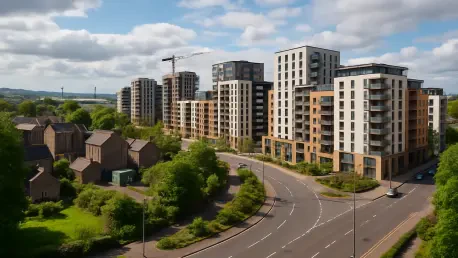I’m thrilled to sit down with Luca Calarailli, a seasoned expert in construction, design, and architecture, whose passion for integrating innovative technology into the industry has made him a leading voice in urban regeneration. Today, we’re diving into his insights on a transformative project in Edinburgh’s Chesser area, a mixed-use development that promises to reshape the city’s landscape. Our conversation explores the vision behind this ambitious scheme, the balance between heritage and modernity, the push for sustainable design, and the critical role it plays in addressing Edinburgh’s housing challenges.
Can you give us a broad picture of the Chesser regeneration project in Edinburgh and what it aims to achieve?
Absolutely, Joshua. The Chesser project, located just west of Edinburgh’s city center, is a major mixed-use development designed to meet some of the city’s most pressing needs. At its core, it’s about creating a vibrant, sustainable community by delivering 779 new homes while preserving the area’s historical character. The main goal is to tackle the housing shortage in Edinburgh, providing a mix of accommodations that cater to different demographics, from students to families. It’s also about revitalizing an underused site, making it a valuable part of the city’s fabric again, and ensuring it aligns with broader urban growth and sustainability objectives.
How does the housing mix in this project reflect the diverse needs of Edinburgh’s population?
We’ve carefully planned the housing to address a wide range of demands. Out of the 779 homes, 100 are affordable apartments, which are crucial for supporting lower-income residents and helping ease the housing crisis. Then we have 293 build-to-rent homes, aimed at young professionals and families looking for flexible, high-quality rental options. Additionally, there are 406 purpose-built student accommodation bedrooms, which are vital given the growing student population in Edinburgh and the pressure on existing housing stock. This mix ensures we’re not just building homes but creating inclusive communities.
There were some challenges with noise concerns during the planning phase. Can you walk us through how that unfolded?
Yes, noise was a significant issue that needed careful handling. After the City of Edinburgh Council initially approved the project in late 2022, the Scottish Government called it in for further review in early 2023 to scrutinize potential noise impacts, particularly given the site’s proximity to busy areas. The concerns centered around how the development might affect residents’ quality of life and whether mitigation measures were adequate. We worked closely with authorities to address these issues, conducting detailed assessments and incorporating design adjustments. Ultimately, we satisfied the conditions set by the ministers, securing final approval with specific planning requirements in place.
Heritage plays a significant role in this development. Can you share the story behind the site’s historical elements?
The Chesser site has a fascinating history tied to its early twentieth-century roots as part of an agricultural market. It’s home to several listed buildings that, while iconic, have sadly fallen into disrepair over the years. These structures represent a piece of Edinburgh’s industrial and cultural past, and preserving them was non-negotiable for us. We’ve collaborated with the City of Edinburgh Council and Historic Environment Scotland to develop a restoration plan that safeguards key features. The centerpiece is the creation of a publicly accessible ‘Heritage Square,’ which will serve as a communal space where people can connect with the site’s history while enjoying a modern environment.
Sustainability is clearly a priority for this project. What specific measures are you taking to ensure it’s eco-friendly?
Sustainability is at the heart of everything we’re doing here. We’re targeting a BREEAM ‘Excellent’ rating, which is a globally recognized standard for environmental performance. To achieve this, we’re incorporating air source heat pumps to provide efficient, low-carbon heating, and photovoltaic solar panels to generate renewable energy on-site. These technologies will significantly cut carbon emissions. Beyond that, we’ve embedded green design principles into the layout and materials to minimize the environmental footprint. It’s about creating a development that’s not just good for today but responsible for tomorrow.
Affordable housing is a critical piece of this puzzle. How are you ensuring it meets the community’s needs?
Affordable housing is indeed a cornerstone of this project. We’re delivering 100 apartments specifically for this purpose, and we’re in discussions with a local registered provider to manage them once completed. This partnership ensures that the homes are allocated effectively to those who need them most, whether it’s families or individuals struggling with housing costs. By integrating these units into the broader development, we’re not only addressing part of Edinburgh’s housing shortage but also fostering a mixed, inclusive community where everyone has a place.
There’s been talk of a national housing emergency in Scotland. How does this project fit into that larger context?
The housing emergency declared by the Scottish Government in 2024 underscores the acute shortage of homes across the country, and Edinburgh feels this pressure intensely due to its growing population and limited supply. Our project directly responds to this crisis by adding nearly 800 new homes across different tenures, relieving some of the strain on the city’s housing market. It’s not just about numbers, though; it’s about delivering quality, accessible living spaces in a highly connected location. We’re contributing to a solution that balances immediate needs with long-term urban planning goals.
Looking ahead, what is your forecast for the future of urban regeneration in cities like Edinburgh?
I think the future of urban regeneration in cities like Edinburgh will hinge on finding harmony between growth and preservation. We’ll see an even stronger push for sustainable, mixed-use developments that address housing shortages while respecting cultural heritage. Technology will play a bigger role—think smart buildings and data-driven planning to optimize space and resources. But the real challenge will be ensuring these projects remain community-focused, prioritizing affordability and inclusivity. Edinburgh has a unique opportunity to lead by example, blending its rich history with innovative urban solutions, and I’m optimistic we’ll see more projects that strike this balance in the coming years.









